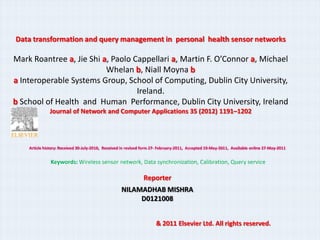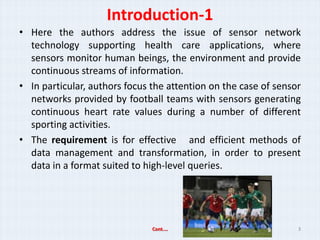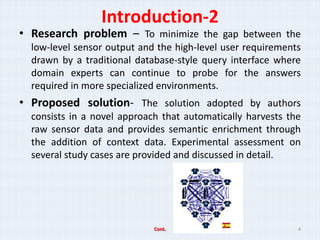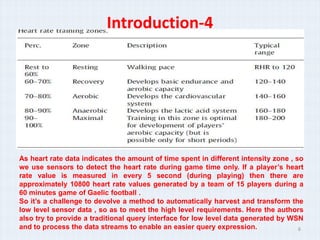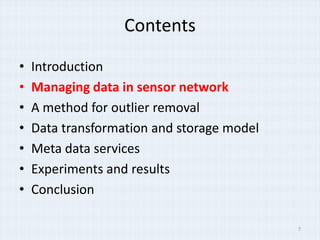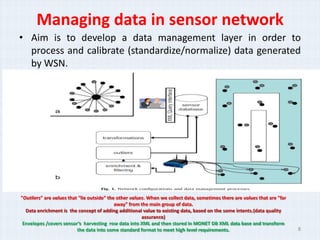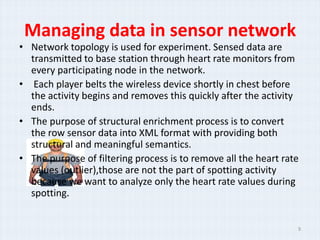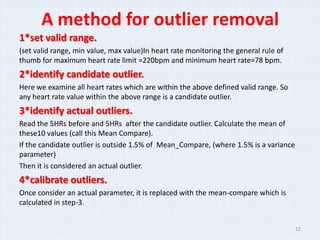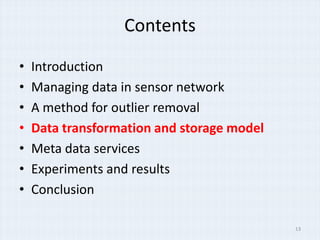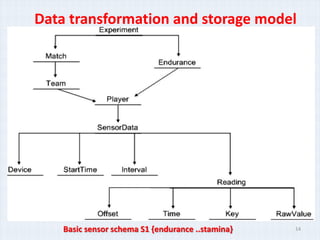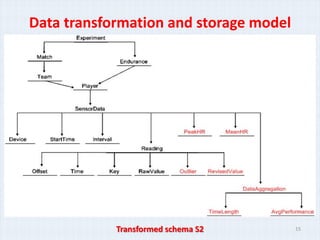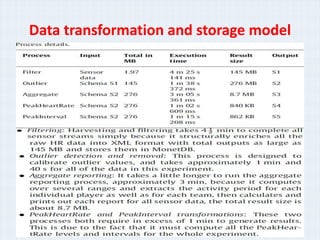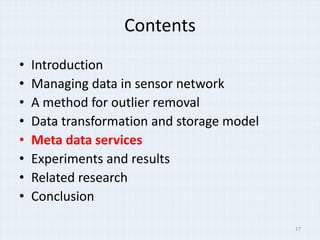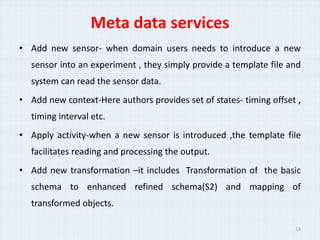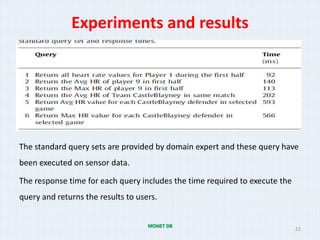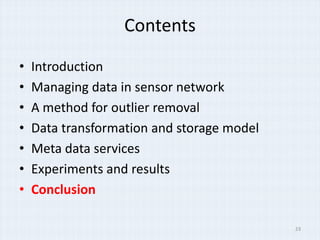Data transformation and query management in personal health sensor network
- 1. Data transformation and query management in personal health sensor networks Mark Roantree a, Jie Shi a, Paolo Cappellari a, Martin F. OˇŻConnor a, Michael Whelan b, Niall Moyna b a Interoperable Systems Group, School of Computing, Dublin City University, Ireland. b School of Health and Human Performance, Dublin City University, Ireland Journal of Network and Computer Applications 35 (2012) 1191¨C1202 Article history: Received 30-July-2010, Received in revised form 27- February-2011, Accepted 10-May-2011, Available online 27-May-2011 Keywords: Wireless sensor network, Data synchronization, Calibration, Query service Reporter NILAMADHAB MISHRA D0121008 & 2011 Elsevier Ltd. All rights reserved.
- 2. Contents ? Introduction ? Managing data in sensor network ? A method for outlier removal ? Data transformation and storage model ? Meta data services ? Experiments and results ? Conclusion 2
- 3. Introduction-1 ? Here the authors address the issue of sensor network technology supporting health care applications, where sensors monitor human beings, the environment and provide continuous streams of information. ? In particular, authors focus the attention on the case of sensor networks provided by football teams with sensors generating continuous heart rate values during a number of different sporting activities. ? The requirement is for effective and efficient methods of data management and transformation, in order to present data in a format suited to high-level queries. Cont.ˇ 3
- 4. Introduction-2 ? Research problem ¨C To minimize the gap between the low-level sensor output and the high-level user requirements drawn by a traditional database-style query interface where domain experts can continue to probe for the answers required in more specialized environments. ? Proposed solution- The solution adopted by authors consists in a novel approach that automatically harvests the raw sensor data and provides semantic enrichment through the addition of context data. Experimental assessment on several study cases are provided and discussed in detail. Cont. 4
- 5. Introduction-3 ? The main motivational background to do this research- Gaelic football is the most popular sport in Ireland. It is a hybrid of Rugby and Australian Rules football. This project assessed heart rate responses during small sided and regular Gaelic football games in young players. To achieve this, author created a wireless sensor network that has multiple configurations and requires a sophisticated data management layer to process, normalize and query the data streams. ? The aim is to determine if the maximal heart rate is attained by all players while varying two parameters: the size of the playing area and the number of players per team. The challenge is how to capture and make sense of the large volumes of data that will be gathered during each experiment. 5
- 6. Introduction-4 As heart rate data indicates the amount of time spent in different intensity zone , so we use sensors to detect the heart rate during game time only. If a playerˇŻs heart rate value is measured in every 5 second (during playing) then there are approximately 10800 heart rate values generated by a team of 15 players during a 60 minutes game of Gaelic football . So itˇŻs a challenge to devolve a method to automatically harvest and transform the low level sensor data , so as to meet the high level requirements. Here the authors also try to provide a traditional query interface for low level data generated by WSN and to process the data streams to enable an easier query expression. 6
- 7. Contents ? Introduction ? Managing data in sensor network ? A method for outlier removal ? Data transformation and storage model ? Meta data services ? Experiments and results ? Conclusion 7
- 8. Managing data in sensor network ? Aim is to develop a data management layer in order to process and calibrate (standardize/normalize) data generated by WSN. "Outliers" are values that "lie outside" the other values. When we collect data, sometimes there are values that are "far away" from the main group of data. Data enrichment is the concept of adding additional value to existing data, based on the some intents.(data quality assurance) Envelopes /covers sensorˇŻs harvesting row data into XML and then stored in MONET DB XML data base and transform the data into some standard format to meet high level requirements. 8
- 9. Managing data in sensor network ? Network topology is used for experiment. Sensed data are transmitted to base station through heart rate monitors from every participating node in the network. ? Each player belts the wireless device shortly in chest before the activity begins and removes this quickly after the activity ends. ? The purpose of structural enrichment process is to convert the row sensor data into XML format with providing both structural and meaningful semantics. ? The purpose of filtering process is to remove all the heart rate values (outlier),those are not the part of spotting activity because we want to analyze only the heart rate values during spotting. 9
- 10. Contents ? Introduction ? Managing data in sensor network ? A method for outlier removal ? Data transformation and storage model ? Meta data services ? Experiments and results ? Conclusion 10
- 11. A method for outlier removal ? Here the authors try to develop a new process for identifying and eliminating the outlier values generated by sensors. ? In all sensor network the sensor will generate outlier values which are clearly outside the normal acceptable range, so before any query or transformation of data can progress, it is required to detect and calibrate these outliers. ? Here authors propose a generic model that operates on XML sensor output and can be parameterized by domain specialist. ? There are 4 primary steps ----- 1*set valid range. 2*identify candidate outlier. 3*identify actual outliers. 4*calibrate outliers. 11
- 12. A method for outlier removal 1*set valid range. (set valid range, min value, max value)In heart rate monitoring the general rule of thumb for maximum heart rate limit =220bpm and minimum heart rate=78 bpm. 2*identify candidate outlier. Here we examine all heart rates which are within the above defined valid range. So any heart rate value within the above range is a candidate outlier. 3*identify actual outliers. Read the 5HRs before and 5HRs after the candidate outlier. Calculate the mean of these10 values (call this Mean Compare). If the candidate outlier is outside 1.5% of Mean_Compare, (where 1.5% is a variance parameter) Then it is considered an actual outlier. 4*calibrate outliers. Once consider an actual parameter, it is replaced with the mean-compare which is calculated in step-3. 12
- 13. Contents ? Introduction ? Managing data in sensor network ? A method for outlier removal ? Data transformation and storage model ? Meta data services ? Experiments and results ? Conclusion 13
- 14. Data transformation and storage model Basic sensor schema S1 {endurance ..stamina} 14
- 15. Data transformation and storage model Transformed schema S2 15
- 16. Data transformation and storage model 16
- 17. Contents ? Introduction ? Managing data in sensor network ? A method for outlier removal ? Data transformation and storage model ? Meta data services ? Experiments and results ? Related research ? Conclusion 17
- 18. Meta data services 18
- 19. Meta data services ? Add new sensor- when domain users needs to introduce a new sensor into an experiment , they simply provide a template file and system can read the sensor data. ? Add new context-Here authors provides set of states- timing offset , timing interval etc. ? Apply activity-when a new sensor is introduced ,the template file facilitates reading and processing the output. ? Add new transformation ¨Cit includes Transformation of the basic schema to enhanced refined schema(S2) and mapping of transformed objects. 19
- 20. Contents ? Introduction ? Managing data in sensor network ? A method for outlier removal ? Data transformation and storage model ? Meta data services ? Experiments and results ? Conclusion 20
- 21. Experiments and results MONET DB 21
- 22. Experiments and results The standard query sets are provided by domain expert and these query have been executed on sensor data. The response time for each query includes the time required to execute the query and returns the results to users. MONET DB 22
- 23. Contents ? Introduction ? Managing data in sensor network ? A method for outlier removal ? Data transformation and storage model ? Meta data services ? Experiments and results ? Conclusion 23
- 24. Conclusion ? Here the authors focused on how exercise scientist developed a series of health sensor networks to monitor the physical effects on different spotting activities on young children. ? The development of meta model and meta data service facilitates the customization of transformation process. ? Suggests the automated process of transforming data generated by sensors into a schema based format to provide interface for a wide users community. 24

